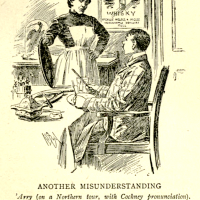 C.S. Lewis is well known to revere nature in his writings, including vivid pictures in The Narnia series, Perelandra (from his space trilogy), and The Great Divorce. His imagery of purity and wonderful holiness often takes hold of his characters’ hearts when they gaze upon the natural world. He gives us images of city children exploring the magical forest of Narnia, an academic philologist dropped onto an unfallen world of beautiful and bountiful islands, and the departed who have made the journey from grey limbo to the vivid borderlands of Heaven, turning their own forms into a comparably pale vapour who can’t bear to stand on the heavenly grass.
C.S. Lewis is well known to revere nature in his writings, including vivid pictures in The Narnia series, Perelandra (from his space trilogy), and The Great Divorce. His imagery of purity and wonderful holiness often takes hold of his characters’ hearts when they gaze upon the natural world. He gives us images of city children exploring the magical forest of Narnia, an academic philologist dropped onto an unfallen world of beautiful and bountiful islands, and the departed who have made the journey from grey limbo to the vivid borderlands of Heaven, turning their own forms into a comparably pale vapour who can’t bear to stand on the heavenly grass.
Lewis himself often expressed his spiritual and intellectual dependence on nature. From sitting in his garden to roaming the country lanes, some of his best mind-clearing and praying happened in the fresh air.
These scenarios, I have always thought, accomplish the difficult feat of showing the wonder of God’s creation while impressing on the reader (who is granted the experience alongside the character) God’s general bigness. This bigness is a powerful exhibition when a smaller being, aka us, comes face to face with it and realizes our own…er… smallness.
In the things God has created we draw near to him, naturally.
So what happens when humanity tries to replicate this effect, when we crave something visual or tangible to mark something as divine or Holy?
 In Till We Have Faces, Lewis creates Glome, whose cultural understanding of holiness is actually quite dreadful and dark. In the temple of Ungit, the smell of blood, the painted faces, and the haunting music were all immediately recognized as “holy”, and would prick the senses of Orual and cause her to shudder. Each time she encountered something pertaining to the goddess Unguit she identified two things: holy and unpleasant.
In Till We Have Faces, Lewis creates Glome, whose cultural understanding of holiness is actually quite dreadful and dark. In the temple of Ungit, the smell of blood, the painted faces, and the haunting music were all immediately recognized as “holy”, and would prick the senses of Orual and cause her to shudder. Each time she encountered something pertaining to the goddess Unguit she identified two things: holy and unpleasant.
The smell of blood is, of course, a fairly standard idea in a temple. Many gods throughout mythology demanded blood sacrifice, even in the Hebrew Old Testament animal sacrifices were the way to cleanse sins.
It’s the painted faces of the temple girls that I specifically find interesting. Again, like animal sacrifice, temple prostitutes are not unique to this story. But Lewis’s vision of the painted faces caught my attention. Was it to dehumanize these girls because of their purpose? Were the extreme colours a human attempt to impersonate the vastness of the gods, a weak imitation with human hands? When the character Psyche reflects on having her face painted (and being drugged) she recalls that she didn’t fully feel like herself anymore, that the painted mask on her skin created someone different upon her.
I wonder, did all the temple girls forget themselves? Did they ever start to believe they actually were some sort of divine being? Did they feel trapped and desolate, or elevated and holy?
Queen Orual puts her culture into an easy question when she asks: “Why must holiness be so dark?”
 Yet, even after a lifetime with this brand of “holiness,” the moment when she seeks her sister in the wilderness and comes to the valley of Psyche’s husband, she immediately realizes it is the land of the gods. She identifies this, even though there is no sign of what she has been raised to view as holy. As far as we know it didn’t smell like blood, there were no drugged painted girls, there were no old men with bird masks or frightening music haunting her ears.
Yet, even after a lifetime with this brand of “holiness,” the moment when she seeks her sister in the wilderness and comes to the valley of Psyche’s husband, she immediately realizes it is the land of the gods. She identifies this, even though there is no sign of what she has been raised to view as holy. As far as we know it didn’t smell like blood, there were no drugged painted girls, there were no old men with bird masks or frightening music haunting her ears.
Without these trained triggers, she still identified true holiness without being taught.
Rather, she was experiencing beauty and holiness away from the temple and palace and in the natural world. Her glimpse of the god himself along with the sound of his voice shocked her entire being, though awful and powerful he was also beautiful and awe-inspiring.
Likewise, when Orual encounters the counsel of the dead, Psyche and the god of the mountain, she is overcome with their greatness. She never describes them as dark and unpleasant, but is actually overwhelmed by their wholeness. This parallels in my mind to Moses (a person raised as royalty in a polytheistic culture similar to Orual) glimpsing only the back of God through a crack in the mountain, and being so overcome his own face shines in a reflection of God’s glory.
I guess this begs the question: did Lewis see this man-made bungled sense of holiness in our world? What things do I associate with Godliness that are not even close? Since we are imago dei, I do believe the things we create using our gifts can reflect God’s holiness. After all, God gives gifts of certain skills and provides inspiration for all sorts of things: architecture, paintings, music, the written word, and more. All things that can reflect God’s holiness. Perhaps the key is dependant upon who is being reflected. Pointing to our creator? Or grotesquely painting the face of hypocrisy and calling it righteous?
 Katie Stevenson: Art and Bible College graduate, graphic and web designer. Wife and mama currently living in southwest Nova Scotia. I love music, reading and travelling. In the guestbook at our wedding a close friend wrote “do more than read and drink tea” and I’ve continued to disregard that advice! One life highlight was assisting Brenton with transcribing Charles Williams’s Chapel of the Thorn at the Wade Centre in Chicago (and seeing the wardrobe!).
Katie Stevenson: Art and Bible College graduate, graphic and web designer. Wife and mama currently living in southwest Nova Scotia. I love music, reading and travelling. In the guestbook at our wedding a close friend wrote “do more than read and drink tea” and I’ve continued to disregard that advice! One life highlight was assisting Brenton with transcribing Charles Williams’s Chapel of the Thorn at the Wade Centre in Chicago (and seeing the wardrobe!).






















Pingback: The Top New Posts of 2020 on A Pilgrim in Narnia | A Pilgrim in Narnia
Pingback: 2020: A Year of Reading: The Nerd Bit, with Charts | A Pilgrim in Narnia
Pingback: CSL:LMM, C.S. Lewis and L.M. Montgomery (Throwback Thursday) | A Pilgrim in Narnia
Pingback: Why is Tolkien Scholarship Stronger than Lewis Scholarship? Part 2: Literary Breadth and Depth | A Pilgrim in Narnia
Pingback: 5 Affordable Ways to Purchase Digital Books By and About C.S. Lewis | A Pilgrim in Narnia
Pingback: Three Myths Retold: Madeline Miller’s Song of Achilles, Margaret Atwood’s Penelopiad, and C.S. Lewis’ Till We Have Faces | A Pilgrim in Narnia
Pingback: Good C.S. Lewis Studies Books That Did Not Win the Mythopoeic Award: Part 1: C.S. Lewis on Theology, Philosophy, and Spiritual Life | A Pilgrim in Narnia
Pingback: Marsha Daigle-Williamson’s Reflecting the Eternal and Dante in the Work of C.S. Lewis, with Thoughts about Intertextuality (Good C.S. Lewis Studies Books That Did Not Win the Mythopoeic Award Series Insert) | A Pilgrim in Narnia
Pingback: Marsha Daigle-Williamson’s Reflecting the Eternal and Dante in the Work of C.S. Lewis, with Thoughts about Intertextuality (Good C.S. Lewis Studies Books That Did Not Win the Mythopoeic Award Series Insert) | A Pilgrim in Narnia
Pingback: Good C.S. Lewis Studies Books That Did Not Win the Mythopoeic Award: Part 3: Literary Studies on C.S. Lewis | A Pilgrim in Narnia
Pingback: The C.S. Lewis Studies Series: Part 5: Recent and Foundational Studies on Lewis and Gender | A Pilgrim in Narnia
Pingback: A Note on C.S. Lewis and the “Tragic Splendour” of British Monarchy on Queen Elizabeth’s Diamond Jubilee | A Pilgrim in Narnia
Pingback: A Note on the “Tragic Splendour” of British Monarchy at the Passing of Queen Elizabeth II | A Pilgrim in Narnia
Pingback: A Rationale for Teaching C.S. Lewis’ Fiction in The Wrong Order | A Pilgrim in Narnia